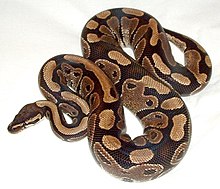Ball python
| Ball python | |
|---|---|
 |
|
| Scientific classification | |
| Kingdom: | Animalia |
| Phylum: | Chordata |
| Class: | Reptilia |
| Order: | Squamata |
| Suborder: | Serpentes |
| Family: | Pythonidae |
| Genus: | Python |
| Species: | P. regius |
| Binomial name | |
|
Python regius (Shaw, 1802) |
|
| Synonyms | |
The ball python (Python regius), also known as the royal python, is a python species found in sub-Saharan Africa. Like all other pythons, it is a non-venomous constrictor. This is the smallest of the African pythons and is popular in the pet trade, largely due to its small size and typically docile temperament. No subspecies are currently recognized. They can live quite long, with the oldest on record living more than 47 years. To achieve something near this age in captivity they require proper care (clean tank, clean water, etc.). The name "ball python" refers to the animal's tendency to curl into a ball when stressed or frightened. The name "royal python"(from the Latin regius) comes from the fact that rulers in Africa would wear the python as jewelry.
Adults generally do not grow to more than 152–182 cm (5.0–6.0 ft). Females tend to be slightly bigger than males, maturing at an average of 122–137 cm (4.0–4.5 ft). Males usually average around 90–107 cm (3.0–3.5 ft). The build is stocky while the head is relatively small. The scales are smooth and both sexes have anal spurs on either side of the vent. Although males tend to have larger spurs, this is not definitive, and sex is best determined via manual eversion of the male hemipenes or inserting a probe into the cloaca to check the presence of an inverted hemipenis (if male). When probing to determine sex, males typically measure eight to 10 subcaudal scales, and females typically measure two to four subcaudal scales.
The color pattern is typically black or dark brown with light brown or gold sides and dorsal blotches. The belly is a white or cream that may include scattered black markings. However, those in the pet industries have, through selective breeding, developed many morphs (genetic mutations) with altered colors and patterns.
They are found in west Africa from Senegal, Mali, Guinea-Bissau, Guinea, Sierra Leone, Liberia, Ivory Coast, Ghana, Benin, and Nigeria through Cameroon, Chad and the Central African Republic to Sudan and Uganda. No type locality was given in the original description.
...
Wikipedia

